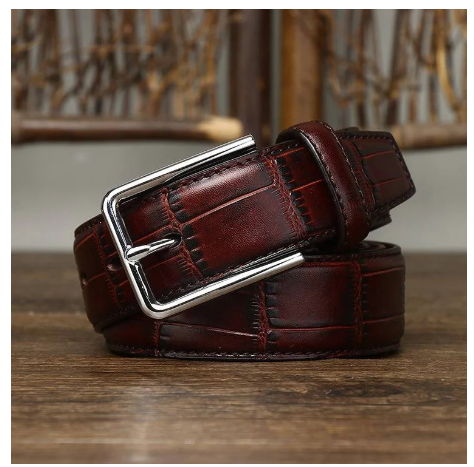The Complete Guide to Men’s Dress Belts
A carefully selected belt is a subtle yet accessory that can transform a man’s outfit from mundane elegant. Though frequently overlooked, the right belt plays a crucial role in achieving a refined. This guide examines the intricacies of men’s dress belts, including their history, styles, materials, colors, sizes, and how to coordinate them with different outfits.

The History of Men’s Dress Belts
Belts have a rich history that traces back to the Bronze Age. Initially, they served a practical purpose, securing clothing and carrying tools or weapons. It wasn’t until the late 19th and early 20th centuries that belts became a standard fashion accessory for men, replacing suspenders as the primary means of keeping trousers in place. Nowadays, men’s dress belts are not just functional; they also serve as an important fashion statement.
Types of Men’s Dress Belts
Men’s dress belts can generally be classified by their buckle styles and strap designs.
1. Buckle Styles
Frame-Style Buckle: The most prevalent type for dress belts, it consists of a frame and a prong that fits into a hole in the strap to secure it.
Plate-Style Buckle: Common in Western-style belts, this buckle features a plate that attaches to the strap.
Box-Frame Buckle A rarer type where the strap is woven through a metal box, tightening the belt.
2. Strap Styles
Smooth Leather A timeless choice for men’s dress belts, offering a sleek and refined appearance.
Embossed or Textured Leather: Introduces subtle design elements, adding a hint of personality while maintaining formality.
Exotic Leathers: Crafted from materials such as alligator or ostrich, these belts are luxurious and come with a higher price tag.
Materials
The material used for a belt greatly affects its aesthetic appeal, durability, and price. Common materials for men’s dress belts include:
1. Leather
Full-Grain Leather: The highest quality, recognized for its strength and natural look.
Top-Grain Leather: Slightly less durable than full-grain but still sturdy and more affordable.
Genuine Leather: Derived from the lower layers of the hide, it tends to be less durable and budget-friendly.
2. Exotic Skins
Alligator/Crocodile: Valued for their unique texture and premium price, adding a touch of luxury.
Ostrich: Known for its distinct quill patterns, it is softer and more flexible.
Lizard: Offers an elegant texture and is often used for more formal styles.
Colors and Finishes
The color of a dress belt is crucial for complementing outfits. The most popular colors include:
Black: The most adaptable and formal choice, ideal for business and upscale events.
Brown: Available in various shades, from light tan to deep chocolate, good for pairing with brown shoes and casual attire.
Burgundy/Oxblood: A stylish but less conventional option that adds a splash of color.
Finishes can range from matte to high gloss, with patent leather being the most formal choice.
Sizing
Getting the right size is essential for both comfort and style. The general guideline suggests selecting a belt size that is 1-2 inches larger than your pant size. For instance, if you wear a size 34 pant, a size 36 belt would typically be ideal. The belt should fit comfortably in the center hole, with enough length to thread through the first belt loop.
Coordinating Men’s Dress Belts with Outfits
A well-coordinated belt can effortlessly pull together an ensemble. Here are some essential tips:
1. Coordinating with Shoes
Material and Color: Aim for your belt to closely match your shoes in both color and material—black with black, brown with brown, etc.
Formality: Align the formality of your belt with your shoes. Patent leather belts are suitable for patent leather shoes, while matte finishes complement more casual leathers.
2. Coordinating with Suits and Trousers
Formal Suits: Stick to classic colors like black or dark brown, ensuring the belt is simple and sleek.
Business Casual: You can be more adventurous with colors and textures but keep it polished and professional.
Casual Outfits: Feel free to experiment with various colors and textures, but aim for a cohesive appearance.
Caring for Your Belt
To prolong the life of your men’s dress belts, proper maintenance is key:
Regular Cleaning: Gently wipe the belt with a damp cloth to remove dust and dirt. Use a leather conditioner periodically to keep the leather in good condition.
Avoid Over-Tightening: This practice can lead to unnecessary wear.
Proper Storage: Use a belt rack or loosely roll belts to prevent creasing.
Men’s dress belts are more than just practical pieces; they are vital components of a well-rounded wardrobe. By familiarizing yourself with the various types, materials, colors, and care techniques, you can ensure your belt adds the perfect finishing touch to your outfit. Investing in high-quality men’s dress belts and maintaining them properly will not only enhance your style but also extend their lifespan. Whether you’re dressing for a formal event or a casual day at work, the right belt can truly make a difference.



